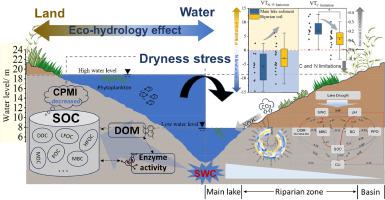当前位置:
X-MOL 学术
›
Water Res.
›
论文详情
Our official English website, www.x-mol.net, welcomes your feedback! (Note: you will need to create a separate account there.)
Eco-hydrological processes regulate lake riparian soil organic matter under dryness stress
Water Research ( IF 11.4 ) Pub Date : 2024-06-12 , DOI: 10.1016/j.watres.2024.121938 Kaiyue Ji 1 , Wei Ouyang 2 , Chunye Lin 1 , Mengchang He 1 , Xitao Liu 1
Water Research ( IF 11.4 ) Pub Date : 2024-06-12 , DOI: 10.1016/j.watres.2024.121938 Kaiyue Ji 1 , Wei Ouyang 2 , Chunye Lin 1 , Mengchang He 1 , Xitao Liu 1
Affiliation

|
As transitional zone between terrestrial and aquatic ecosystems, the soil properties of riparian zones are deeply influenced by the eco-hydrological conditions of lakes. However, with the increasing frequent drought events caused by climate change, the response of riparian soil organic matter (SOM) dynamics to the eco-hydrological process of lakes under dryness stress is unclear. In this study, we utilized the field research, indoor experiments, ecoenzymatic stoichiometry model and data analysis to identify whether riparian SOM and enzyme activity were affected by dryness stress and determine the feedback relationship between soil biochemical properties and lake eco-hydrological processes. The results showed that lake dryness stress reduced the non-vegetated riparian soil quality (the mean Carbon Pool Management Index decreased by 18 % and 6 % for water–land interface (WL) and bare land (BL), respectively), and the humification degree and molecular weight of the riparian soil dissolved organic matter (DOM) (with E/E and E/E value of WL 6.1 and 1.9 times higher than main lake sediment), which was not conducive to soil carbon storage. In addition, lake dryness stress reduced the C-hydrolytic enzyme activity and soil enzyme stoichiometry. The vector and Vector-TER analysis suggested the riparian soil was C and N limitation of the microbial community (vector length of 2.05 ± 0.57 and vector angle of 30.10° ± 7.70°), and dryness had reduced the limitations to some extent. Most notably, we combined structural equation model (SEM) analysis and found that lake dryness stress affects riparian soil organic carbon (SOC) dynamics by significantly affecting microbial biomass carbon (MBC) and soil pH. Finally, the response of riparian zone to eco-hydrological condition under climate change should receive further attention, which can effectively deepen our understanding of the carbon water cycle mechanism in riparian soil under changing environments.
中文翻译:

干旱胁迫下生态水文过程调节湖岸土壤有机质
河岸带作为陆地和水生生态系统的过渡带,其土壤性质深受湖泊生态水文条件的影响。然而,随着气候变化导致的干旱事件日益频繁,干旱胁迫下河岸土壤有机质(SOM)动态对湖泊生态水文过程的响应尚不清楚。本研究通过野外研究、室内实验、生态酶化学计量模型和数据分析,识别了河岸土壤有机质和酶活性是否受到干旱胁迫的影响,并确定了土壤生化性质与湖泊生态水文过程之间的反馈关系。结果表明,湖泊干旱胁迫降低了非植被河岸土壤质量(水陆界面(WL)和裸地(BL)的平均碳库管理指数分别下降了 18% 和 6%),腐殖化作用降低。河岸土壤溶解有机质(DOM)的程度和分子量(E/E和E/E值分别为WL 6.1和1.9倍于主湖沉积物),不利于土壤碳储存。此外,湖泊干旱胁迫降低了C-水解酶活性和土壤酶化学计量。矢量和Vector-TER分析表明河岸土壤受到微生物群落C和N的限制(矢量长度为2.05±0.57,矢量角度为30.10°±7.70°),干燥在一定程度上减轻了这种限制。最值得注意的是,我们结合结构方程模型(SEM)分析发现,湖泊干旱胁迫通过显着影响微生物生物量碳(MBC)和土壤pH来影响河岸土壤有机碳(SOC)动态。 最后,气候变化下河岸带对生态水文条件的响应应受到进一步关注,这可以有效加深我们对变化环境下河岸土壤碳水循环机制的认识。
更新日期:2024-06-12
中文翻译:

干旱胁迫下生态水文过程调节湖岸土壤有机质
河岸带作为陆地和水生生态系统的过渡带,其土壤性质深受湖泊生态水文条件的影响。然而,随着气候变化导致的干旱事件日益频繁,干旱胁迫下河岸土壤有机质(SOM)动态对湖泊生态水文过程的响应尚不清楚。本研究通过野外研究、室内实验、生态酶化学计量模型和数据分析,识别了河岸土壤有机质和酶活性是否受到干旱胁迫的影响,并确定了土壤生化性质与湖泊生态水文过程之间的反馈关系。结果表明,湖泊干旱胁迫降低了非植被河岸土壤质量(水陆界面(WL)和裸地(BL)的平均碳库管理指数分别下降了 18% 和 6%),腐殖化作用降低。河岸土壤溶解有机质(DOM)的程度和分子量(E/E和E/E值分别为WL 6.1和1.9倍于主湖沉积物),不利于土壤碳储存。此外,湖泊干旱胁迫降低了C-水解酶活性和土壤酶化学计量。矢量和Vector-TER分析表明河岸土壤受到微生物群落C和N的限制(矢量长度为2.05±0.57,矢量角度为30.10°±7.70°),干燥在一定程度上减轻了这种限制。最值得注意的是,我们结合结构方程模型(SEM)分析发现,湖泊干旱胁迫通过显着影响微生物生物量碳(MBC)和土壤pH来影响河岸土壤有机碳(SOC)动态。 最后,气候变化下河岸带对生态水文条件的响应应受到进一步关注,这可以有效加深我们对变化环境下河岸土壤碳水循环机制的认识。
















































 京公网安备 11010802027423号
京公网安备 11010802027423号